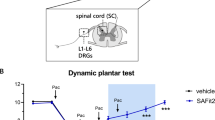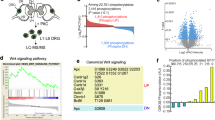Abstract
Painful peripheral neuropathy is a serious dose-limiting side effect of paclitaxel therapy, which unfortunately often happens during the optimal clinical management of chemotherapy in cancer patients. Currently the underlying mechanisms of the painful peripheral neuropathy remain largely unknown. Here, we found that paclitaxel treatment (3 × 8 mg/kg, cumulative dose 24 mg/kg) upregulated the expression of CX3CR1 and phosphorylated Akt1 in DRG and spinal dorsal horn. Blocking of Akt1 pathway activation with different inhibitor (MK-2206 or LY294002) significantly attenuated mechanical allodynia and thermal hyperalgesia induced by paclitaxel. Furthermore, inhibition of CX3CR1 by using neutralizing antibody not only prevented Akt1 activation in DRG and spinal dorsal horn but also alleviated pain-related behavior induced by paclitaxel treatment. This study suggested that CX3CR1/Akt1 signaling pathway may be a potential target for prevention and reversion of the painful peripheral neuropathy induced by paclitaxel.





Similar content being viewed by others
References
Scripture CD, Figg WD, Sparreboom A (2006) Peripheral neuropathy induced by paclitaxel: recent insights and future perspectives. Curr Neuropharmacol 4:165–172
Mielke S, Sparreboom A, Mross K (2006) Peripheral neuropathy: a persisting challenge in paclitaxel-based regimes. Eur J Cancer 42:24–30
Manning BD, Cantley LC (2007) AKT/PKB signaling: navigating downstream. Cell 129:1261–1274
Nicholson KM, Anderson NG (2002) The protein kinase B/Akt signalling pathway in human malignancy. Cell Signal 14:381–395
Fayard E, Tintignac LA, Baudry A, Hemmings BA (2005) Protein kinase B/Akt at a glance. J Cell Sci 118:5675–5678
Sun FY, Guo X (2005) Molecular and cellular mechanisms of neuroprotection by vascular endothelial growth factor. J Neurosci Res 79:180–184
Fukunaga K, Shioda N (2009) Pathophysiological relevance of forkhead transcription factors in brain ischemia. Forkhead Transcr Factors Vital Elem Biol Med 665:130–142
Ma WY, Chabot JG, Quirion R (2006) A role for adrenomedullin as a pain-related peptide in the rat. Proc Natl Acad Sci USA 103:16027–16032
Shi TJS, Huang P, Mulder J, Ceccatelli S, Hokfelt T (2009) Expression of p-Akt in sensory neurons and spinal cord after peripheral nerve injury. Neurosignals 17:203–212
Masure S, Haefner B, Wesselink JJ, Hoefnagel E, Mortier E, Verhasselt P, Tuytelaars A, Gordon R, Richardson A (1999) Molecular cloning, expression and characterization of the human serine/threonine kinase Akt-3. Eur J Biochem FEBS 265:353–360
Lindia JA, McGowan E, Jochnowitz N, Abbadie C (2005) Induction of CX3CL1 expression in astrocytes and CX3CR1 in microglia in the spinal cord of a rat model of neuropathic pain. J Pain 6:434–438
Harrison JK, Jiang Y, Chen S, Xia Y, Maciejewski D, McNamara RK, Streit WJ, Salafranca MN, Adhikari S, Thompson DA, Botti P, Bacon KB, Feng L (1998) Role for neuronally derived fractalkine in mediating interactions between neurons and CX3CR1-expressing microglia. Proc Natl Acad Sci USA 95:10896–10901
Watkins LR, Maier SF (2003) Glia: a novel drug discovery target for clinical pain. Nat Rev Drug Discovery 2:973–985
Huang ZZ, Li D, Liu CC, Cui Y, Zhu HQ, Zhang WW, Li YY, Xin WJ (2014) CX3CL1-mediated macrophage activation contributed to paclitaxel-induced DRG neuronal apoptosis and painful peripheral neuropathy. Brain Behav Immun 40:155–165
Li D, Huang ZZ, Ling YZ, Wei JY, Cui Y, Zhang XZ, Zhu HQ, Xin WJ (2015) Up-regulation of CX3CL1 via Nuclear Factor-κB-dependent histone acetylation is involved in paclitaxel-induced peripheral neuropathy. Anesthesiology 122(5):1142–1151. doi:10.1097/ALN.0000000000000560
Bryant VL, Slade CA (2015) Chemokines, their receptors and human disease: the good, the bad and the itchy. Immunol Cell Biol 93:364–371
Stephen J, Benson RA, Fraser AR, Graham GJ, Nibbs RJ, Garside P, Brewer JM (2012) Understanding and manipulating chemokines and their receptors to improve vaccine adjuvant design. Immunology 137:771
Xu L, Kitade H, Ni Y, Ota T (2015) Roles of chemokines and chemokine receptors in obesity-associated insulin resistance and nonalcoholic fatty liver disease. Biomolecules 5:1563–1579
Guan XH, Fu QC, Shi D, Bu HL, Song ZP, Xiong BR, Shu B, Xiang HB, Xu B, Manyande A, Cao F, Tian YK (2015) Activation of spinal chemokine receptor CXCR3 mediates bone cancer pain through an Akt-ERK crosstalk pathway in rats. Exp Neurol 263:39–49
Guo G, Gao F (2015) CXCR3: latest evidence for the involvement of chemokine signaling in bone cancer pain. Exp Neurol 265:176–179
Lee SJ, Namkoong S, Kim YM, Kim CK, Lee H, Ha KS, Chung HT, Kwon YG (2006) Fractalkine stimulates angiogenesis by activating the Raf-1/MEK/ERK- and PI3K/Akt/eNOS-dependent signal pathways. Am J Physiol Heart Circ Physiol 291:H2836–H2846
Wada A, Ito A, Iitsuka H, Tsuneyama K, Miyazono T, Murakami J, Shibahara N, Sakurai H, Saiki I, Nakayama T, Yoshie O, Koizumi K, Sugiyama T (2015) Role of chemokine CX3CL1 in progression of multiple myeloma via CX3CR1 in bone microenvironments. Oncol Rep 33:2935–2939
LoPachin RM, Rudy TA, Yaksh TL (1981) An improved method for chronic catheterization of the rat spinal subarachnoid space. Physiol Behav 27:559–561
Weng HR, Cordella JV, Dougherty PM (2003) Changes in sensory processing in the spinal dorsal horn accompany vincristine-induced hyperalgesia and allodynia. Pain 103:131–138
Liu CC, Lu N, Cui Y, Yang T, Zhao ZQ, Xin WJ, Liu XG (2010) Prevention of paclitaxel-induced allodynia by minocycline: effect on loss of peripheral nerve fibers and infiltration of macrophages in rats. Mol Pain 6:76
Hargreaves K, Dubner R, Brown F, Flores C, Joris J (1988) A new and sensitive method for measuring thermal nociception in cutaneous hyperalgesia. Pain 32:77–88
Chen H, Jiang YS, Sun Y, Xiong YC (2015) p38 and interleukin-1 beta pathway via toll-like receptor 4 contributed to the skin and muscle incision and retraction-induced allodynia. J Surg Res 197:339–347
Patruno A, Franceschelli S, Pesce M, Maccallini C, Fantacuzzi M, Speranza L, Ferrone A, De Lutiis MA, Ricciotti E, Amoroso R, Felaco M (2012) Novel aminobenzyl-acetamidine derivative modulate the differential regulation of NOSs in LPS induced inflammatory response: role of PI3K/Akt pathway. Biochim Biophys Acta 1820:2095–2104
Xu JT, Tu HY, Xin WJ, Liu XG, Zhang GH, Zhai CH (2007) Activation of phosphatidylinositol 3-kinase and protein kinase B/Akt in dorsal root ganglia and spinal cord contributes to the neuropathic pain induced by spinal nerve ligation in rats. Exp Neurol 206:269–279
Clark AK, Staniland AA, Malcangio M (2011) Fractalkine/CX3CR1 signalling in chronic pain and inflammation. Curr Pharm Biotechnol 12:1707–1714
Zhu W, Acosta C, MacNeil B, Cortes C, Intrater H, Gong Y, Namaka M (2013) Elevated expression of fractalkine (CX3CL1) and fractalkine receptor (CX3CR1) in the dorsal root ganglia and spinal cord in experimental autoimmune encephalomyelitis: implications in multiple sclerosis-induced neuropathic pain. BioMed Res Int 2013:480702
Brazil DP, Yang ZZ, Hemmings BA (2004) Advances in protein kinase B signalling: aKTion on multiple fronts. Trends Biochem Sci 29:233–242
Schultze SM, Jensen J, Hemmings BA, Tschopp O, Niessen M (2011) Promiscuous affairs of PKB/AKT isoforms in metabolism. Arch Physiol Biochem 117:70–77
Guedes RP, Araujo AS, Janner D, Bello-Klein A, Ribeiro MF, Partata WA (2008) Increase in reactive oxygen species and activation of Akt signaling pathway in neuropathic pain. Cell Mol Neurobiol 28:1049–1056
Sun R, Yan J, Willis WD (2007) Activation of protein kinase B/Akt in the periphery contributes to pain behavior induced by capsaicin in rats. Neuroscience 144:286–294
Xu Q, Fitzsimmons B, Steinauer J, O’Neill A, Newton AC, Hua XY, Yaksh TL (2011) Spinal phosphinositide 3-kinase-Akt-mammalian target of rapamycin signaling cascades in inflammation-induced hyperalgesia. J Neurosci 31:2113–2124
Gu X, Ma Z, Bo J, Sun X (2012) Effects of Akt3 gene knockout on neuropathic pain induced by chronic constriction injury of sciatic nerve: 14AP1-2. Eur J Anaesthesiol 29:193
Kay JC, Xia CM, Liu M, Shen S, Yu SJ, Chung C, Qiao LY (2013) Endogenous PI3K/Akt and NMDAR act independently in the regulation of CREB activity in lumbosacral spinal cord in cystitis. Exp Neurol 250:366–375
Shih MH, Kao SC, Wang W, Yaster M, Tao YX (2012) Spinal cord NMDA receptor-mediated activation of mammalian target of rapamycin is required for the development and maintenance of bone cancer-induced pain hypersensitivities in rats. J Pain 13:338–349
Xu QH, Fitzsimmons B, Steinauer J, O’ Neill A, Newton AC, Hua XY, Yaksh TL (2011) Spinal phosphinositide 3-kinase-Akt-mammalian target of rapamycin signaling cascades in inflammation-induced hyperalgesia. J Neurosci 31:2113–2124
Thomas S, Baumgart DC (2012) Targeting leukocyte migration and adhesion in Crohn’s disease and ulcerative colitis. Inflammopharmacology 20:1–18
Ferretti E, Pistoia V, Corcione A (2014) Role of fractalkine/CX3CL1 and its receptor in the pathogenesis of inflammatory and malignant diseases with emphasis on B cell malignancies. Mediators Inflamm 2014:480941
Clark AK, Malcangio M (2014) Fractalkine/CX3CR1 signaling during neuropathic pain. Front Cell Neurosci 8:121
Zhuang ZY, Kawasaki Y, Tan PH, Wen YR, Huang J, Ji RR (2007) Role of the CX3CR1/p38 MAPK pathway in spinal microglia for the development of neuropathic pain following nerve injury-induced cleavage of fractalkine. Brain Behav Immun 21:642–651
Cao H, Zheng JW, Li JJ, Meng B, Li J, Ge RS (2014) Effects of curcumin on pain threshold and on the expression of nuclear factor kappa B and CX3C receptor 1 after sciatic nerve chronic constrictive injury in rats. Chin J Integr Med 20:850–856
Aksoy MO, Yang Y, Ji R, Reddy PJ, Shahabuddin S, Litvin J, Rogers TJ, Kelsen SG (2006) CXCR3 surface expression in human airway epithelial cells: cell cycle dependence and effect on cell proliferation. Am J Physiol Lung Cell Mol Physiol 290:L909–L918
Maru SV, Holloway KA, Flynn G, Lancashire CL, Loughlin AJ, Male DK, Romero IA (2008) Chemokine production and chemokine receptor expression by human glioma cells: role of CXCL10 in tumour cell proliferation. J Neuroimmunol 199:35–45
Meucci O, Fatatis A, Simen AA, Miller RJ (2000) Expression of CX(3)CR1 chemokine receptors on neurons and their role in neuronal survival. Proc Natl Acad Sci USA 97:8075–8080
Klosowska K, Volin MV, Huynh N, Chong KK, Halloran MM, Woods JM (2009) Fractalkine functions as a chemoattractant for osteoarthritis synovial fibroblasts and stimulates phosphorylation of mitogen-activated protein kinases and Akt. Clin Exp Immunol 156:312–319
Ma F, Zhang L, Oz HS, Mashni M, Westlund KN (2015) Dysregulated TNFalpha promotes cytokine proteome profile increases and bilateral orofacial hypersensitivity. Neuroscience 300:493–507
Ochi-ishi R, Nagata K, Inoue T, Tozaki-Saitoh H, Tsuda M, Inoue K (2014) Involvement of the chemokine CCL3 and the purinoceptor P2X7 in the spinal cord in paclitaxel-induced mechanical allodynia. Mol Pain 10:53
Willemen HL, Eijkelkamp N, Wang H, Dantzer R, Dorn GW 2nd, Kelley KW, Heijnen CJ, Kavelaars A (2010) Microglial/macrophage GRK2 determines duration of peripheral IL-1beta-induced hyperalgesia: contribution of spinal cord CX3CR1, p38 and IL-1 signaling. Pain 150:550–560
Acknowledgements
This study was funded by National Natural Science Foundation of China (81070894), 1255 Discipline Construction Program Foundation of the First Affiliated Hospital of SMMU(125532200), and Guangdong provincial science and technology project (2013B022000029), People’s Republic of China.
Author information
Authors and Affiliations
Corresponding authors
Ethics declarations
Conflict of interest
The authors declare that they have no conflict of interests.
Additional information
Dai Li and Hui Chen have contributed equally to this work.
Rights and permissions
About this article
Cite this article
Li, D., Chen, H., Luo, XH. et al. CX3CR1-Mediated Akt1 Activation Contributes to the Paclitaxel-Induced Painful Peripheral Neuropathy in Rats. Neurochem Res 41, 1305–1314 (2016). https://doi.org/10.1007/s11064-016-1827-y
Received:
Revised:
Accepted:
Published:
Issue Date:
DOI: https://doi.org/10.1007/s11064-016-1827-y




